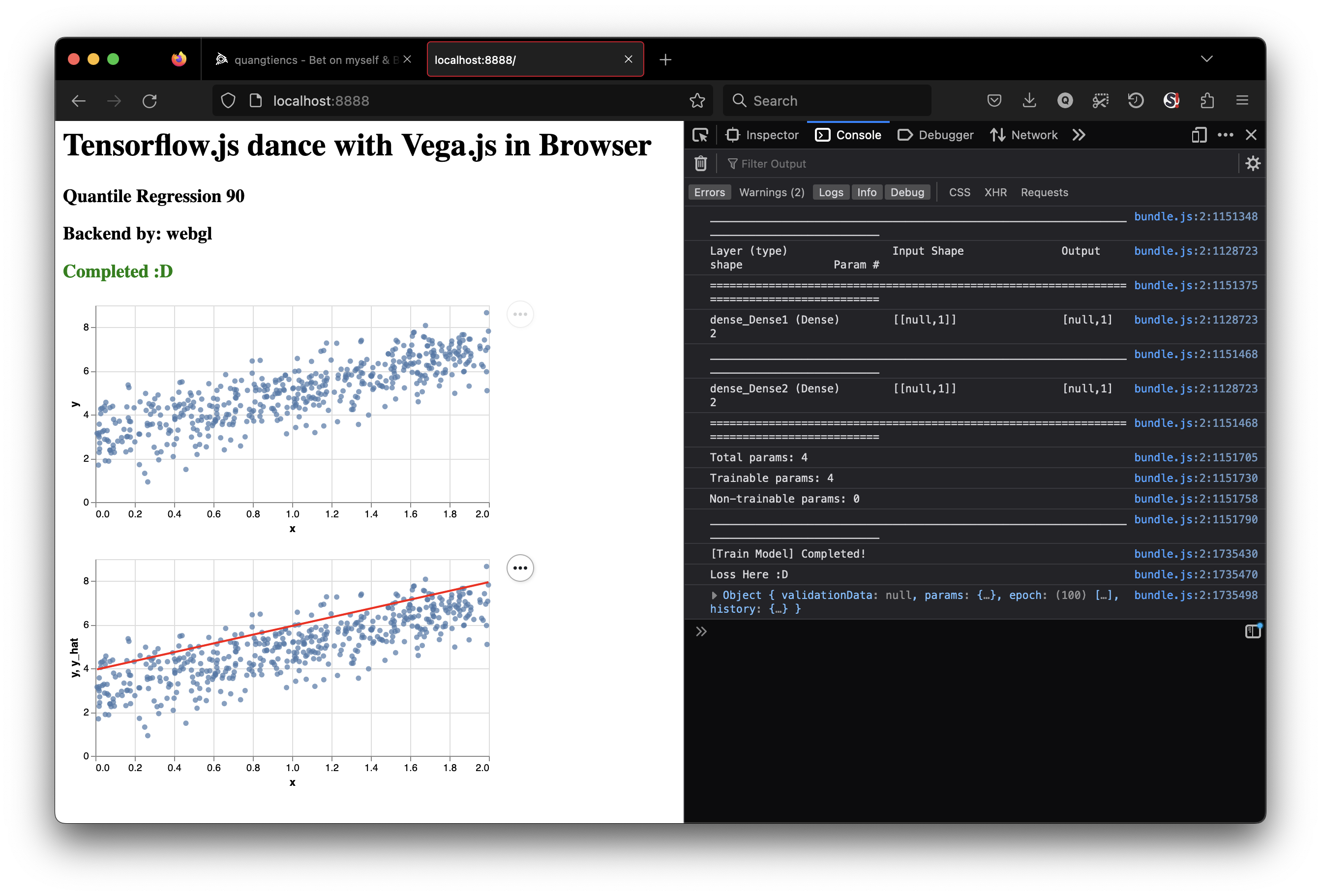[playground] Tensorflow.Js & Typescript [4]: Quantile Regression
Quantile Regression is one of the practical techniques for many real problems. In this tutorial, we will implement a custom loss for TensorflowJS.
Quantile Loss:
$$\mathcal{L}(y_{\mathtt{true}}, y_{\mathtt{pred}}) = \begin{cases} (y_{\mathtt{true}} - y_{\mathtt{pred}}) \alpha &\text{if } y_{\mathtt{true}} \ge y_{\mathtt{pred}} \\ (y_{\mathtt{true}} - y_{\mathtt{pred}}) (\alpha - 1) &\text{if } y_{\mathtt{true}} < y_{\mathtt{pred}} \end{cases} $$
Or for easy computing:
$$\mathcal{L}(y_{\mathtt{true}}, y_{\mathtt{pred}}) = \mathtt{max}((y_{\mathtt{true}} - y_{\mathtt{pred}}) \alpha, (y_{\mathtt{true}} - y_{\mathtt{pred}}) (\alpha - 1)) $$
Quantile Regression:
import { Tensor, Tensor2D, tensor2d } from "@tensorflow/tfjs";
import embed from "vega-embed";
import * as tf from "@tensorflow/tfjs";
try {
// I know. I'm lazy :-D
tf.setBackend("webgl");
} catch (err) {
console.log(err);
}
document.querySelector("#device")!!.innerHTML =
`Backend by: ${tf.getBackend()}`;
function make_synthetic_data(true_w: number, true_b: number) {
let x: tf.Tensor1D = tf.randomUniform([500], 0.0, 2.0);
let noise = tf.randomNormal([500], 0, 0.8);
let y = x.mul(tf.scalar(true_w)).add(tf.scalar(true_b)).add(noise);
return { "x": x, "y": y };
}
let data = make_synthetic_data(2, 3);
let vegaData: { x: number; y: number }[] = [];
for (let i = 0; i < data.x.size; i++) {
vegaData.push({ "x": data.x.dataSync()[i], "y": data.y.dataSync()[i] });
}
function quantileLoss90(yTrue: tf.Tensor, yPred: tf.Tensor) {
let error = yTrue.sub(yPred);
let alpha = 0.9;
return tf.maximum(error.mul(alpha), error.mul(alpha - 1.0)).mean();
}
let model = tf.sequential();
model.add(tf.layers.dense({ inputShape: [1], units: 1 }));
model.add(tf.layers.dense({ units: 1 }));
model.compile({
optimizer: "sgd",
loss: quantileLoss90,
});
model.summary();
model.fit(data.x, data.y, { epochs: 100, batchSize: 64 }).then((history) => {
document.querySelector("#status")!!.innerHTML = "Completed :D";
document.querySelector("#status")!!.setAttribute("style", "color: green");
const prediction = (model.predict(data.x) as tf.Tensor)
.dataSync();
// console.log(`data sync ${prediction}`);
console.log("[Train Model] Completed!");
console.log("Loss Here :D");
console.log(history);
let finalPlotData = [];
for (let i = 0; i < data.x.size; i++) {
finalPlotData.push({
"x": data.x.dataSync()[i],
"y": data.y.dataSync()[i],
"y_hat": prediction[i],
});
}
// @ts-ignore
var specquantile = {
"$schema": "https://vega.github.io/schema/vega-lite/v5.json",
"width": 400,
"height": 200,
data: {
values: finalPlotData,
},
"layer": [{
"mark": "circle",
"encoding": {
"x": { "field": "x", "type": "quantitative" },
"y": { "field": "y", "type": "quantitative" },
},
}, {
"mark": "line",
"encoding": {
"x": { "field": "x", "type": "quantitative" },
"y": { "field": "y_hat", "type": "quantitative" },
"color": { "value": "red" },
},
}],
};
// @ts-ignore
embed("#quantileregression", specquantile);
});
var specDataPoint = {
"$schema": "https://vega.github.io/schema/vega-lite/v5.json",
"width": 400,
"height": 200,
data: {
values: vegaData,
},
"mark": "circle",
"encoding": {
"x": { "field": "x", "type": "quantitative" },
"y": { "field": "y", "type": "quantitative" },
},
};
// @ts-ignore
embed("#vis", specDataPoint);
:-) and… don’t forget tf.tidy

